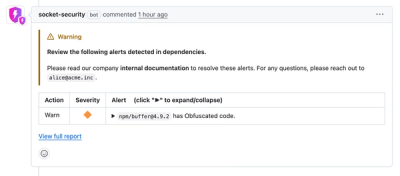
Security News
Crates.io Users Targeted by Phishing Emails
The Rust Security Response WG is warning of phishing emails from rustfoundation.dev targeting crates.io users.
@contentstack/cli-cm-seed
Advanced tools
create a Stack from existing content types, entries, assets, etc.
The “seed” command in Contentstack CLI allows users to import content to your stack, from Github repositories. It's an effective command that can help you to migrate content to your stack with minimal steps.
To import content to your stack, you can choose from the following two sources:
Contentstack’s organization: In this organization, we have provided sample content, which you can import directly to your stack using the seed command.
Github’s repository: You can import content available on Github’s repository belonging to an organization or an individual.
csdx cm:stacks:seed [--repo <value>] [--org <value>] [-k <value>] [-n <value>] [-y <value>] [-s <value>] [--locale <value>]csdx cm:stacks:seed [--repo <value>] [--org <value>] [-k <value>] [-n <value>] [-y <value>] [-s <value>] [--locale <value>]csdx cm:stacks:seed [--repo <value>] [--org <value>] [-k <value>] [-n <value>] [-y <value>] [-s <value>] [--locale <value>]Create a stack from existing content types, entries, assets, etc
USAGE
$ csdx cm:seed cm:stacks:seed [--repo <value>] [--org <value>] [-k <value>] [-n <value>] [-y <value>] [-s
<value>] [--locale <value>]
FLAGS
-a, --alias=<value> Alias of the management token
-k, --stack-api-key=<value> Provide stack API key to seed content to
-n, --stack-name=<value> Name of a new stack that needs to be created.
-o, --org=<value> Provide Organization UID to create a new stack
-r, --repo=<value> GitHub organization name or GitHub user name/repository name.
-s, --stack=<value> Provide the stack UID to seed content.
-y, --yes=<value> [Optional] Skip the stack confirmation.
DESCRIPTION
Create a stack from existing content types, entries, assets, etc
ALIASES
$ csdx cm:seed
EXAMPLES
$ csdx cm:stacks:seed
$ csdx cm:stacks:seed --repo "account"
$ csdx cm:stacks:seed --repo "account/repository"
$ csdx cm:stacks:seed --repo "account/repository" --stack-api-key "stack-api-key" //seed content into specific stack
$ csdx cm:stacks:seed --repo "account/repository" --org "your-org-uid" --stack-name "stack-name" //create a new stack in given org uid
csdx cm:stacks:seed [--repo <value>] [--org <value>] [-k <value>] [-n <value>] [-y <value>] [-s <value>] [--locale <value>]Create a stack from existing content types, entries, assets, etc
USAGE
$ csdx cm:stacks:seed [--repo <value>] [--org <value>] [-k <value>] [-n <value>] [-y <value>] [-s <value>]
[--locale <value>]
FLAGS
-a, --alias=<value> Alias of the management token
-k, --stack-api-key=<value> Provide stack API key to seed content to
-n, --stack-name=<value> Name of a new stack that needs to be created.
-o, --org=<value> Provide Organization UID to create a new stack
-r, --repo=<value> GitHub organization name or GitHub user name/repository name.
-s, --stack=<value> Provide the stack UID to seed content.
-y, --yes=<value> [Optional] Skip the stack confirmation.
DESCRIPTION
Create a stack from existing content types, entries, assets, etc
ALIASES
$ csdx cm:seed
EXAMPLES
$ csdx cm:stacks:seed
$ csdx cm:stacks:seed --repo "account"
$ csdx cm:stacks:seed --repo "account/repository"
$ csdx cm:stacks:seed --repo "account/repository" --stack-api-key "stack-api-key" //seed content into specific stack
$ csdx cm:stacks:seed --repo "account/repository" --org "your-org-uid" --stack-name "stack-name" //create a new stack in given org uid
See code: src/commands/cm/stacks/seed.ts
The following flags allow you to host and import Stacks from your own GitHub repository. The account name can be a personal user account, organization account, or enterprise account.
$ csdx cm:seed -r "account/repository"
Step 1. Export a Stack
Identify a Stack that you would like to export. This stack might be used in conjunction with a sample web site or mobile app you have created.
Now, run csdx cm:export against it. The following documentation explains the Export Plugin.
In most cases, running csdx cm:export -A or csdx cm:export -a "management token" should work for you.
The csdx cm:seed plugin uses the same libraries as csdx cm:import.
Step 2. GitHub
Once the Stack is exported:
stack-. For example: stack-your-starter-app.
Doing so will allow the stack names to be found by the interactive prompt when running csdx cm:seed -r "account".
This step is optional. You can fully qualify the repository name if required: csdx cm:seed -r "account/repo.stack within the newly created GitHub repositorystack folderThe latest release will be downloaded and extracted, when a user attempts to install a Stack using:
$ csdx cm:seed -r "account"
$ csdx cm:seed -r "account/repository"
To get more detailed documentation of this command, visit the Seed command documentation on our docs.
FAQs
create a Stack from existing content types, entries, assets, etc.
The npm package @contentstack/cli-cm-seed receives a total of 3,818 weekly downloads. As such, @contentstack/cli-cm-seed popularity was classified as popular.
We found that @contentstack/cli-cm-seed demonstrated a healthy version release cadence and project activity because the last version was released less than a year ago. It has 2 open source maintainers collaborating on the project.
Did you know?

Socket for GitHub automatically highlights issues in each pull request and monitors the health of all your open source dependencies. Discover the contents of your packages and block harmful activity before you install or update your dependencies.

Security News
The Rust Security Response WG is warning of phishing emails from rustfoundation.dev targeting crates.io users.

Product
Socket now lets you customize pull request alert headers, helping security teams share clear guidance right in PRs to speed reviews and reduce back-and-forth.

Product
Socket's Rust support is moving to Beta: all users can scan Cargo projects and generate SBOMs, including Cargo.toml-only crates, with Rust-aware supply chain checks.